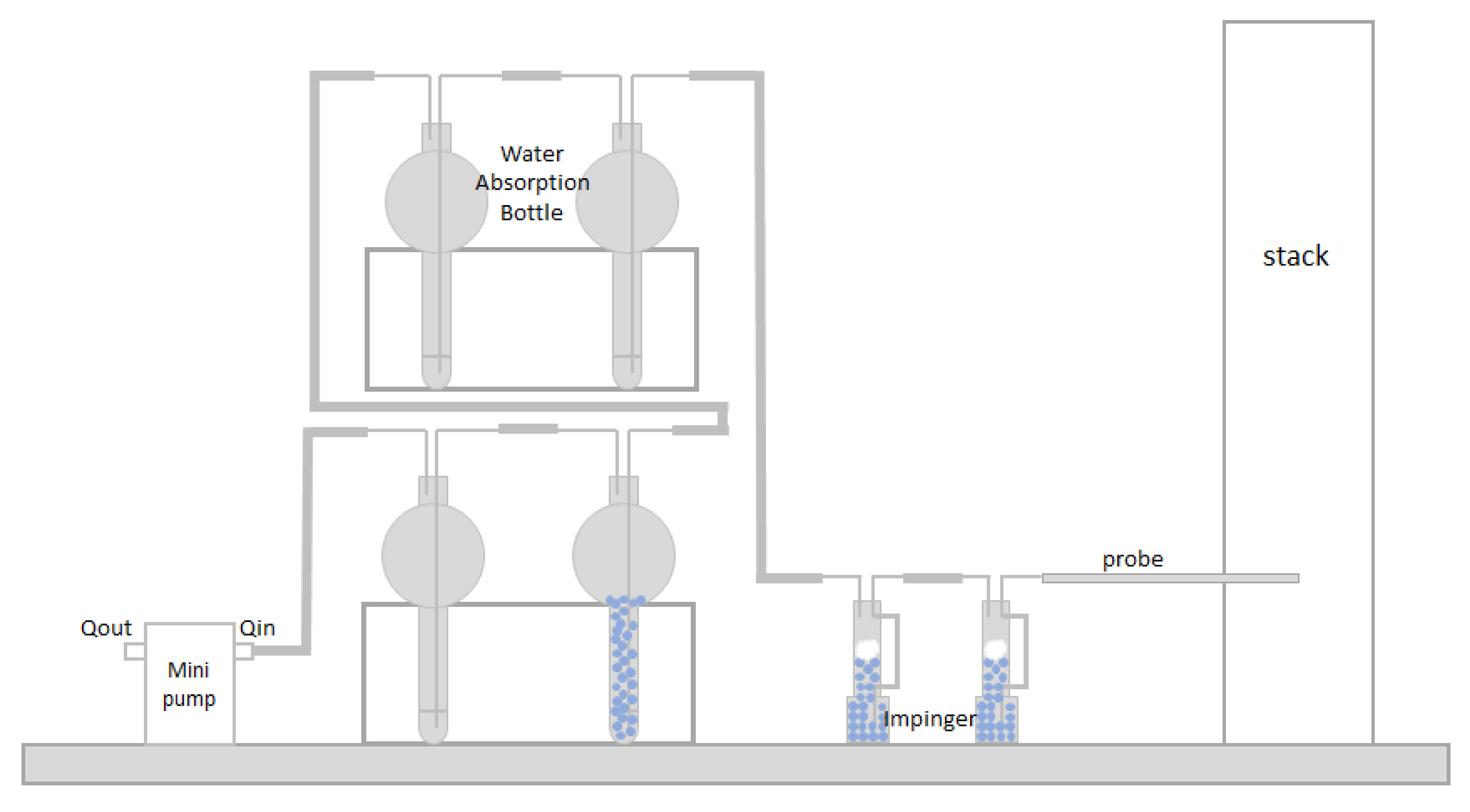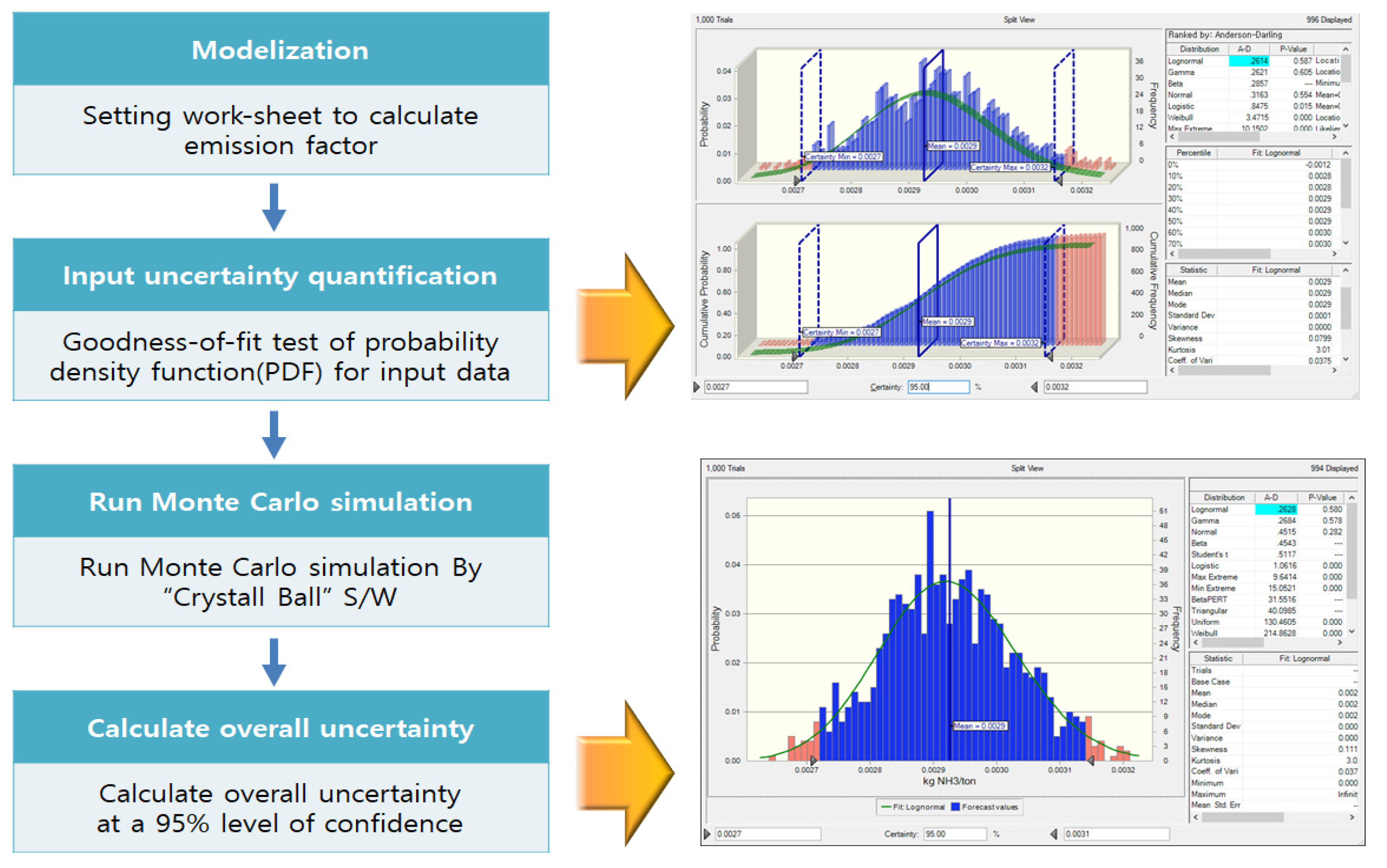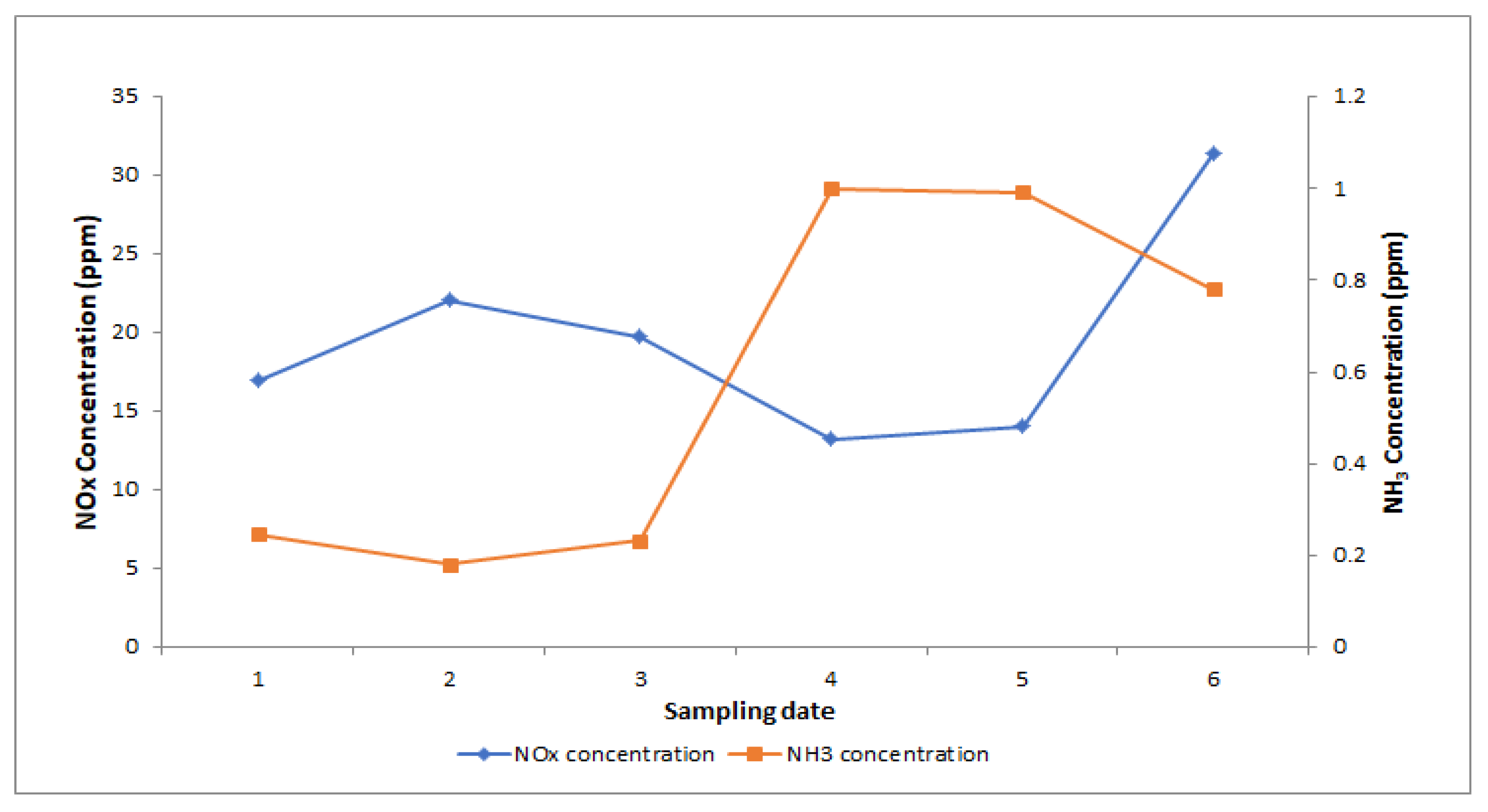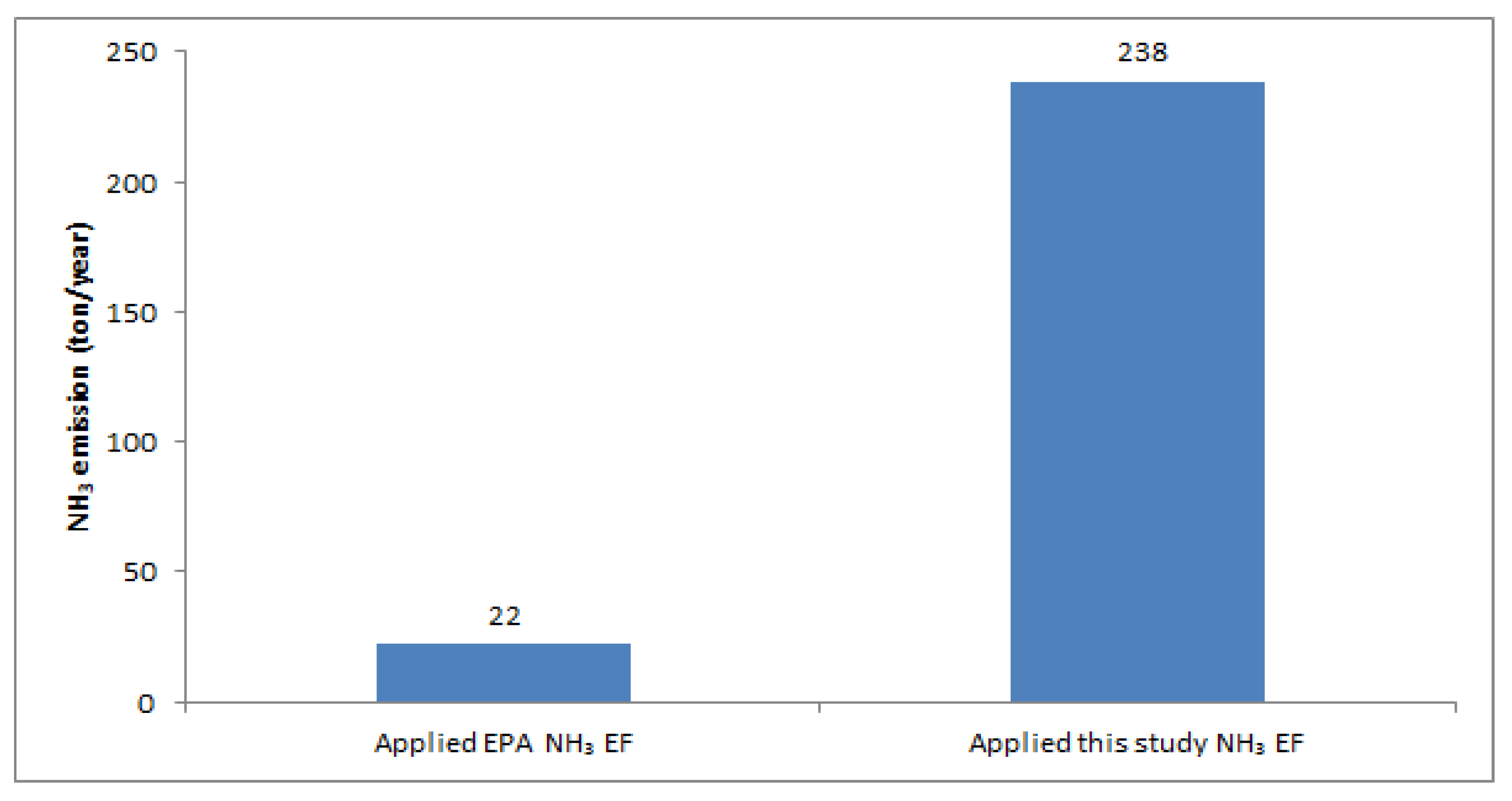Emission Characteristics of Ammonia at Bituminous Coal Power Plant
Abstract
1. Introduction
2. Method
2.1. Selection of Objective Facilities
2.2. Analysis of Ammonia at Bituminous Coal Power Plant
2.3. Development of NH3 Emission Factor
2.4. Uncertainty Analysis by Monte Carlo Simulation
3. Result and Discussion
3.1. Characteristics of NH3 Emission
3.2. NH3 Emission Factor and Comparison of NH3 Emissions
3.3. Uncertainty of NH3 Emission Factor
4. Conclusions
Author Contributions
Funding
Acknowledgments
Conflicts of Interest
References
- KEI(Korea Environmet Institute). Basic Research on Ammonia Management Policy for Reduction of Secondary Generation Fine Dust; Korea Environmet Institute: Sejong, Korea, 2017. [Google Scholar]
- Weixiang, Z.; Hopke, P.K. Source apportionment for ambient particles in the San Gorgonio wilderness. Atmos. Environ. 2004, 38, 5901–5910. [Google Scholar] [CrossRef]
- Gibson, M.D.; Pierce, J.R.; Waugh, D.; Kuchta, J.S.; Chisholm, L.; Duck, T.J.; Hopper, J.T.; Beauchamp, S.; King, G.H.; Franklin, J.E.; et al. Identifying the sources driving observed PM2.5 temporal variability over Halifax, Nova Scotia, during BORTAS-B. Atmos. Chem. Phys. 2013, 13, 7199–7213. [Google Scholar] [CrossRef]
- Ahmad, M.; Cheng, S.; Yu, Q.; Qin, W.; Zhang, Y.; Chen, J. Chemical and source characterization of PM2.5 in summertime in severely polluted Lahore, Pakistan. Atmos. Res. 2020, 234, 104715. [Google Scholar] [CrossRef]
- Agarwal, A.; Satsangi, A.; Lakhani, A.; Kumari, K.M. Seasonal and spatial variability of secondary inorganic aerosols in PM2.5 at Agra: Source apportionment through receptor models. Chemosphere 2020, 242, 125132. [Google Scholar] [CrossRef] [PubMed]
- Environmental Preservation Association. POLICY & ISSUES Environment column: Air Pollutant Total Management System. Environ. Inf. 2015, 416, 2–5. [Google Scholar]
- Rhee, V.A. Reveiw of the Special Act on the Seoul Metropolitan Air Improvement: The Total Mass emissions Managements and the Tradable Permit Programs. Public Law J. 2007, 8, 255–280. [Google Scholar]
- Moon, T.H.; Hur, J.W. Linking the Total Pollution Load Management System (TPLMS) and the Total Industrial Site Volume Control System (ISVCS) in the Capital Region, Korea. J. Korea Plan. Assoc. 2009, 44, 19–30. [Google Scholar]
- Wu, Y.; Gu, B.; Erisman, J.W.; Reis, S.; Fang, Y.; Lu, X.; Zhang, X. PM2.5 pollution is substantially affected by ammonia emissions in China. Environ. Pollut. 2016, 218, 86–94. [Google Scholar] [CrossRef] [PubMed]
- Kim, S.T.; Bae, C.H.; Kim, B.U.; Kim, H.C. PM2.5 Simulations for the Seoul Metropolitan Area: (I) Contributions of Precursor Emissions in the 2013 CAPSS Emissions Inventory. J. Korean Soc. Atmos. Environ. 2017, 33, 139–158. [Google Scholar] [CrossRef]
- San joaquin valley air pollution control district. Demonstration of NH3 Precursor Contributions to PM2.5 in the San Joaquin Valley; San joaquin valley air pollution control district: Fresno, CA, USA, 2019.
- NIER(National Institute of Environmental Research in Korea). 2016 National Air Pollutants Emission; National Institute of Environmental Research in Korea: Incheon, Korea, 2019.
- Ministry of Environment. Standard Methods for the Measurements of Air Pollution; Ministry of Environment in Korea: Seoul, Korea, 2019.
- Law, A.M.; Kelton, W.D. Simulation Modeling and Analysis; McGraw-Hill: New York, NY, USA, 1991. [Google Scholar]
- Winiwarter, W.; Rypdal, K. Assessing the uncertainty associated with national greenhouse gas emission inventories: A case study for Austria. Atmos. Environ. 2001, 35, 5425–5440. [Google Scholar] [CrossRef]
- Zhang, L.; Pierce, J.; Leung, V.L.; Wang, D.; Epling, W.S. Characterization of Ceria’s Interaction with NOx and NH3. J. Phys. Chem. C 2013, 117, 8282–8289. [Google Scholar] [CrossRef]
- U.S. Environmental Protection Agency. Development and Selection of Ammonia Emission Factors Final Report; U.S. Environmental Protection Agency: Washington, DC, USA, 1994.
- Improvement of Reliability and Accuracy of Air Pollutant Emissions (18)-Focusing on Improving Ammonia Emissions; NIER(National Institute of Environmental Research in Korea): Incheon, Korea, 2019.
- Li, Q.; Jiang, J.K.; Cai, S.; Zhou, W.; Wang, S.H.; Duan, L.; Hao, J. Gaseous Ammonia Emissions from Coal and Biomass Combustion in Household Stoves with Different Combustion Efficiencies. Environ. Sci. Technol. Lett. 2016, 3, 98–103. [Google Scholar] [CrossRef]
- IPCC. The 2006 IPCC Guidelines for National Greenhouse Gas Inventories. In General Guidance and Reporting; IPCC: Geneva, Switzerland, 2006; Volume 1. [Google Scholar]





| Site | Capacity (MW) | Fuel Type | Sampling |
|---|---|---|---|
| Power Plant A | 1020 | Bituminous Coal | 16 |
| Power Plant B | 1050 | Bituminous Coal | 10 |
| Power Plant C | 500 | Bituminous Coal | 19 |
| Site | NH3 Concentration (ppm) | SD(Standard Deviation) (ppm) | Sampling | NOx Concentration (ppm) |
|---|---|---|---|---|
| Power Plant A | 0.21 | 0.14 | 16 | 20 |
| Power Plant B | 0.99 | 0.56 | 10 | 14 |
| Power Plant C | 0.27 | 0.21 | 19 | 23 |
| This Study (kgNH3/ton) | US EPA(1994) (kgNH3/ton) | NIER (2019) (kgNH3/ton) [18] |
|---|---|---|
| 0.0029 | 0.00028 | 0.0054 |
© 2020 by the authors. Licensee MDPI, Basel, Switzerland. This article is an open access article distributed under the terms and conditions of the Creative Commons Attribution (CC BY) license (http://creativecommons.org/licenses/by/4.0/).
Share and Cite
Kang, S.; Kim, S.-D.; Jeon, E.-C. Emission Characteristics of Ammonia at Bituminous Coal Power Plant. Energies 2020, 13, 1534. https://doi.org/10.3390/en13071534
Kang S, Kim S-D, Jeon E-C. Emission Characteristics of Ammonia at Bituminous Coal Power Plant. Energies. 2020; 13(7):1534. https://doi.org/10.3390/en13071534
Chicago/Turabian StyleKang, Seongmin, Seong-Dong Kim, and Eui-Chan Jeon. 2020. "Emission Characteristics of Ammonia at Bituminous Coal Power Plant" Energies 13, no. 7: 1534. https://doi.org/10.3390/en13071534
APA StyleKang, S., Kim, S.-D., & Jeon, E.-C. (2020). Emission Characteristics of Ammonia at Bituminous Coal Power Plant. Energies, 13(7), 1534. https://doi.org/10.3390/en13071534






